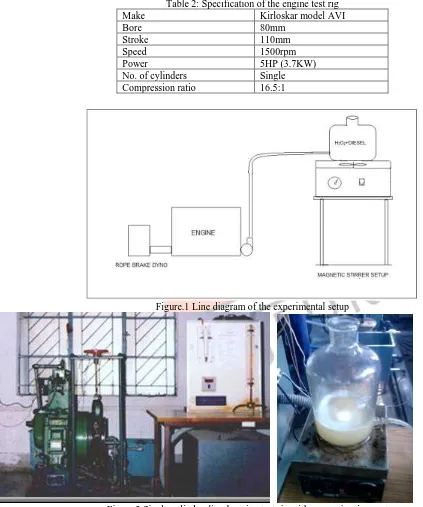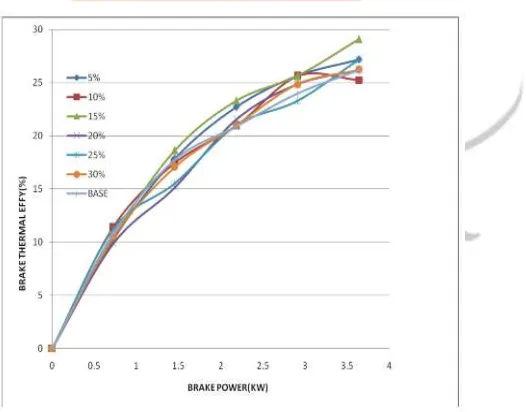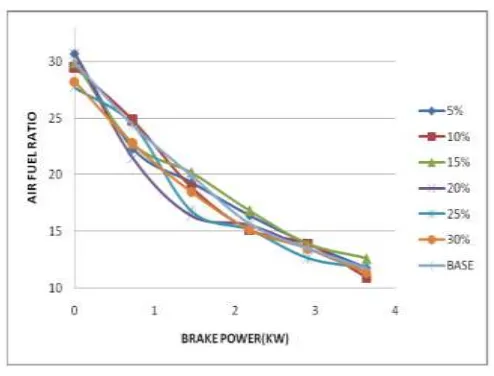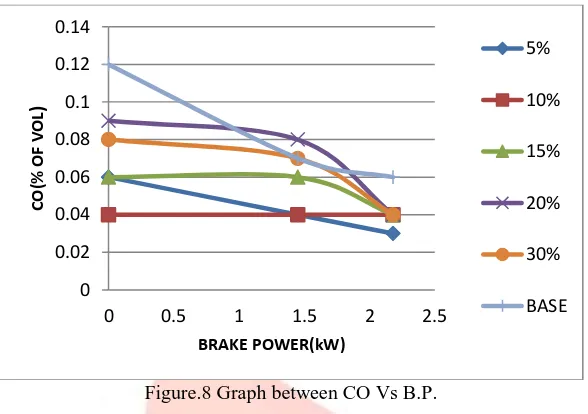IJEDR1804058
International Journal of Engineering Development and Research (
www.ijedr.org
)
308
Performance and emission characteristics of diesel
engine operated with diesel- Hydrogen peroxide
blends
G.Babji1, K.Gowri Sankar2, B.Nagaraju3 1,2,3Assistant Professor
Department of Mechanical engineering
Anil Neerukonda Institute of Technology and Sciences, Vishakapatnam. INDIA
____________________________________________________________________________________________
Abstract--Alternate fuels for diesel is promising for diesel engines as petroleum resources are degrading and causing for higher environmental pollution. Properties of Hydrogen peroxide are suitably affecting the performance and emission characteristics. In this paper experimental investigations are carried out on a four stroke single cylinder diesel engine with diesel and hydrogen peroxide blends. Commercially available low concentrated Hydrogen peroxide is blended in different proportions of the volume to the diesel fuel. As specific gravity differs for both the fuels, a magnetic stirrer setup is used for proper mixing of the blend. Addition of 15% Hydrogen peroxide to the diesel has shown the highest Brake thermal efficiency and specific fuel consumption. 5% Hydrogen peroxide- diesel blend has shown lower HC emissions.
Index terms- Hydrogen peroxide, magnetic stirrer setup, Brake thermal efficiency, specific fuel consumption, emissions.
____________________________________________________________________________________________
I Introduction
Increased usage of diesel fueled vehicles along with degrading of resources results in looking for alternate fuels. High NOx emissions, high exhaust gas temperatures and formation of soot are also the reasons for replacing the diesel fuel with other alternate fuels. Combining diesel with other fuel as an additive would affect the performance and emission characteristics. Addition of additive fuel to the base diesel fuel would affect the performance parameters such as injection time, injection pressure, self-ignition temperature of the fuel, ignition delay, Cetane number of the fuel which in turn affects performance and emission characteristics of diesel engine. One of the reason for using Hydrogen peroxide is only Hydrogen cannot be used directly with diesel because of its higher auto ignition temperature than diesel [3]. Hydrogen Peroxide is a strong oxidizing agent and a weak acid in water solution. It is viable, alternative energy storage medium, competing with hydrogen gas, biogas, biodiesel and alcohol. Hydrogen peroxide tends to decompose exothermically into water and oxygen gas if heated above 80°C with a release of tremendous energy, close to the energy per mole of H2. It also decomposes in light and in the presence of
metal ions or oxidizable organic materials. The rate of decomposition is dependent on the temperature and concentration of the peroxide, as well as the presence of impurities and stabilizers. Along with these properties Hydrogen peroxide (H2O2) has its
own significance to use it as an additive with the diesel fuel in a diesel engine because of its peculiar properties such as strong oxidizer, combustion enhancer. The Cetane number of the H2O2 (150) is significantly higher than that of pure diesel (50)
which is one of the main reason to use it as an additive with the pure diesel [10] [11]. The Table 1 shows the some of the physical and chemical properties of Hydrogen peroxide.
Table 1: Properties of Hydrogen peroxide
Physical and Chemical Properties [ 14 ] Physical state Clear, colorless liquid
Melting point -11oC (90%), -39oC (70%)
Boiling point 141oC (90%), 125oC (70%)
Specific gravity 1.4 (90%), 1.3 (70%)
Solubility in water Infinitely soluble
Ph 1.3(70%)
Vapor density 1.17
Autoignition ___
Nfpa ratings Health: 2; Flammability: 0; Reactivity: 3
Refractive index 1.414
Flash point Not combustible
Stability It may undergo violent decomposition with many organic materials, metals and alkalies as an strong oxidizer.
IJEDR1804058
International Journal of Engineering Development and Research (
www.ijedr.org
)
309
concentrated hydrogen peroxide (30%) along with diesel is used for conducting all performance and emission tests.H2O2 is combined with the base fuel (diesel) in different proportions of volumes such as 5, 10, 15, 20, 25, 30 (%Vol.). Variation in the specific gravities (H2O2:1.39, Diesel: 0.82) causes for the improper blending of hydrogen peroxide with the diesel. So continuous stirring is required for obtaining proper mixture. Magnetic stirrer setup as shown in fig is used for this purpose. It consists of a 12V D.C motor coupled to a shaft containing rotor blades. An aspirator bottle is used as a fuel tank in which both H2O2 and diesel are mixed and the blend is then allowed to enter into the combustion chamber.The entire experimental setup is shown in figure2. The line diagram which is shown in figure 1 illustrates the experimental setup. Specifications of the engine test rig are provided in Table 2. The CRYPTON-290 series analyzer is used for analyzing the exhaust gas emissions. It is fully microprocessor controlled exhaust gas analyzer employing Non-Dispersive Infra-Red (NDIR) techniques. The unit measures carbon monoxide, carbon dioxide, hydro carbons and NOx emissions. A further channel is provided employing Electro chemical measurement of Oxygen.
Table 2: Specification of the engine test rig Make Kirloskar model AVI Bore 80mm
Stroke 110mm Speed 1500rpm Power 5HP (3.7KW) No. of cylinders Single Compression ratio 16.5:1
Figure.1 Line diagram of the experimental setup
Figure.2 Single cylinder diesel engine test rig with magnetic stirrer setup
III Results and discussions: The following parameters have been taken into consideration while drawing performance and emission characteristic curves. The following results and discussions have been made based up on the experiments conducted on the experimental setup.
Performance characteristics:
IJEDR1804058
International Journal of Engineering Development and Research (
www.ijedr.org
)
310
reduction in the SFC at all brake powers which is desirable. It is due to the presence of Hydrogen which causes for the improvement in the combustion performance and Hydrogen has fast flame propagation compared to diesel [1] [6]. Blend having 15% H2O2 showed the less specific fuel consumption compared to remaining compositions. But further increase in the percentage of H2O2 results in increase of SFC as it become leaner mixture since the blend contains more oxygen.Figure 3 Graph between SFC Vs B.P.
Brake thermal efficiency: There is an increase in brake thermal efficiency with increase in load. Figure 4 depicts that addition of Hydrogen peroxide to the base fuel increases the brake thermal efficiency. This is due to the fast flame prorogation of hydrogen and it causes for better combustion [6,7,3]. Addition of H2O2 causes for the decrease of ignition delay which in turn
increases the cetane number of the fuel. And high Cetane number causes better combustion [10]. Blend with 15% hydrogen peroxide showed better brake thermal efficiency compared to other blends. Further increase of the hydrogen peroxide decreased the brake thermal efficiency because of less calorific value of H2O2 compared to diesel fuel [10,11].
Figure 4 Graph between Brake thermal efficiency Vs B.P.
Air fuel Ratio: Figure5 shows the variation of air fuel ratio with respect to brake power for different blends. All blends showed decreased trend with increase in brake power as rich mixture requires at higher loads. From the Figure it is observed that addition of H2O2 causes for the decreasing of air fuel ratio for the blends with 5%, 10% and 20% H2O2, because the blend
replaces some air. But at higher loadsit increases with increase in percentage of Hydrogen peroxide because of the presence of the oxygen in H2O2 [1]. Less air fuel ratio causes for the decrease of ignition delay which is required for better combustion
performance. But further increase of percentage of H2O2 increased the air fuel ratio as H2O2 has less energy content. It is since
IJEDR1804058
International Journal of Engineering Development and Research (
www.ijedr.org
)
311
Figure 5 Air fuel ratio Vs B.P.Emission characteristics:
Hydrocarbons: The emission of HCs are mainly due to the low combustion temperature and at lower loads. Figure6 shows for all blends Hydrocarbons decreasing with increase in brake power. This is due to high combustion temperature at higher brake powers. Base fuel has higher HC emissions compared to remaining blends as diesel causes emission of more hydrocarbons compared to remaining blends. Further 5%H2O2 has shown least HC emissions compared to remaining blends.
Figure 6 Graph between Hydocarbon (HC) Vs B.P.
NOx emissions: Figure 7 shows the variation of NOx emission with different loads.In general NOx emissions occur at high combustion temperatures and Addition of H2O2 causes for the increase of cetane number of fuel blend because H2O2 having a
cetane no. 125 where as pure diesel has 40-55.Higher cetane number causes decrease in ignition delay and improves combustion efficiency [10,13]. It causes for the cleaner exhaust gases with lesser NOx emissions. So addition of higher percentage of H2O2 decreases the NOx emissions. From the figure it shows that at lower loads 25% H2O2 gives less NOx
IJEDR1804058
International Journal of Engineering Development and Research (
www.ijedr.org
)
312
Fig. 7: Graph between NO Vs B.P.Carbon monoxide: Diesel engines are lean combustion engines which require higher air fuel ratio. Emission of carbon monoxide is due to the insufficient air for the combustion process [13]. At start of the combustion that is at lower loads base fuel has higher emission of CO compared to other Diesel H2O2 blends. Since availability of Oxygen is less for pure diesel
compared to remaining blends. Figure 8 shows the variation of CO for different brake powers. And, from the graph base test showed the higher emission of CO as it contains no Hydrogen peroxide. Addition of H2O2 caused the decrease in CO emission
as it is supplying sufficient oxygen for the combustion process
Figure.8 Graph between CO Vs B.P.
IV Conclusion
Hydrogen peroxide is used as blend with the diesel for obtaining the performance and emission characteristics. Experiments were conducted on a Four stroke Single cylinder rope brake dynamometer diesel engine test rig and the following conclusions were made based upon the experimental results.
1. 15%H2O2 with diesel blend has shown Highest brake thermal efficiency and least specific fuel consumption
compared to that of base fuel.
2. 5% H2O2- diesel blend has shown low hydrocarbon (HC) emissions at higher loads.
3. 25% H2O2 – Diesel blend has shown decreased NOx emissions.
4. At no load 25% test has shown higher emissions and 10% has shown lesser emissions. With increase in load 5% has shown lesser emissions even it has slightly higher at no load.
V References
[1] S. Bari, M. Mohammad Esmaeil “ Effect of H2/O2 addition in increasing the thermal efficiency of a diesel engine” Fuel 89 (2010) 378–383
[2] Kim-Bao Nguyen, Tomohisa Dan, Ichiro Asano “Effect of double injection on combustion, performance and emissions of Jatropha water emulsion fueled direct-injection diesel engine” Energy 80 (2015) 746e755
[3] Rachan D Sekhar; H R Purushothama “Hydrogen induction to diesel engine working on Bio diesel: A review” Procedia Earth and Planetary Science 11 ( 2015 ) 385 – 392
[4] Nagaprasad K. S., D. Madhu “Effect of injecting hydrogen peroxide into diesel Engine” International Journal of Engineering Sciences & Emerging Technologies, April 2012. ISSN: 2231 – 6604 Volume 2, Issue 1, pp: 24-28 ©IJESET [5] Bernat Esteban, Jordi-Roger Riba, Grau Baquero, Antoni Rius, Rita Puig “Temperature dependence of density and viscosity of vegetable oils”; biomass and bioenergy 42(2012)164e171
[6] Carl Schaschke , Isobel Fletcher and Norman Glen “Density and Viscosity Measurement of Diesel Fuels at Combined High Pressure and Elevated Temperature” Processes 2013, 1, 30-48; doi:10.3390/pr1020030
[7] Kim-Bao Nguyen , Tomohisa Dan , Ichiro Asano “ Combustion, performance and emission characteristics of direct injection diesel engine fueled by Jatropha hydrogen peroxide emulsion” Energy xxx (2014) 1e8
[8]P. K. Bose, Rahul Banerjee, Madhujit Deb “Effect of hydrogen-diesel combustion on the performance and combustion parameters of a dual fuelled diesel engine” International Journal Of Energy And Environment Volume 4, Issue 3, 2013 pp.497-510 Journal homepage: www.IJEE.IEEFoundation.org
[9] Biplab K. Debnath, Ujjwal K. Saha_ , Niranjan Sahoo “Effect of hydrogen-diesel quantity variation on brake thermal efficiency of a dual fuelled diesel engine” Journal of Power Technologies 92 (1) (2012) 55–67
[10] Zainal Abidin Mohd Yusof, Iqbal Ahmed,Muhammad Saad Khan, S. Altaf Hussain, Ahmad Hussain, Ibrahim bin Abdul Mutalib, Khaled S. Balkhair, Muhammad H. Albeirutty “Thermal Evaluation of Diesel/Hydrogen
Peroxide Fuel Blend” DOI: 10.1002/ceat.201400039 Chem. Eng. Technol. 2015, 38, No. 12, 2170–2180
[11] Muhammad Saad Khan, *1Iqbal Ahmed, 1M I Abdul Mutalib and 1M A Bustam “Characterization of Diesel-Hydrogen Peroxide Fuel Blend” Journal of Energy Technologies and Policy www.iiste.org ISSN 2224-3232 (Paper) ISSN 2225-0573 (Online) Vol.3, No.11, 2013 – Special Issue for International Conference on Energy, Environment and Sustainable Economy (EESE 2013) 0 0.02 0.04 0.06 0.08 0.1 0.12 0.14
0 0.5 1 1.5 2 2.5
IJEDR1804058
International Journal of Engineering Development and Research (
www.ijedr.org
)
313
[12 ] Mardani Ali Sera, Rosli Abu Bakar and Sin Kwan Leong “Effect of fuel density on the performance of a cng fuelled engine” http://www.ngvcommunity.com http://www.ngv.com.my[13] Ibrahim Aslan Res¸itog˘lu, Kemal Altinis¸ik, Ali Keskin “The pollutant emissions from diesel-engine vehicles and exhaust aftertreatment systems” Clean Techn Environ Policy
DOI 10.1007/s10098-014-0793-9



